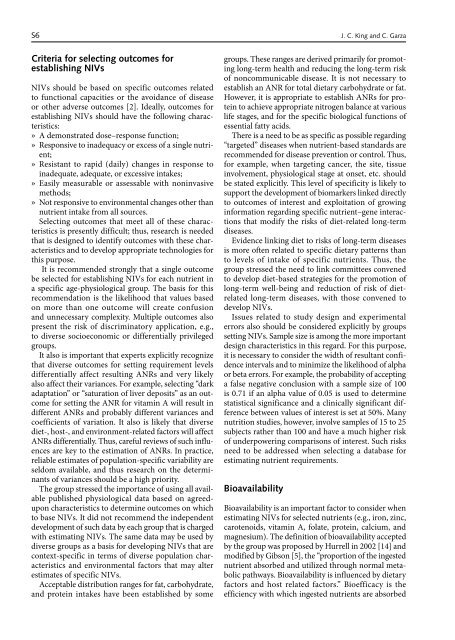Implementing food-based dietary guidelines for - United Nations ...
Implementing food-based dietary guidelines for - United Nations ...
Implementing food-based dietary guidelines for - United Nations ...
Create successful ePaper yourself
Turn your PDF publications into a flip-book with our unique Google optimized e-Paper software.
S6 J. C. King and C. Garza<br />
Criteria <strong>for</strong> selecting outcomes <strong>for</strong><br />
establishing NIVs<br />
NIVs should be <strong>based</strong> on specific outcomes related<br />
to functional capacities or the avoidance of disease<br />
or other adverse outcomes [2]. Ideally, outcomes <strong>for</strong><br />
establishing NIVs should have the following characteristics:<br />
» A demonstrated dose–response function;<br />
» Responsive to inadequacy or excess of a single nutrient;<br />
» Resistant to rapid (daily) changes in response to<br />
inadequate, adequate, or excessive intakes;<br />
» Easily measurable or assessable with noninvasive<br />
methods;<br />
» Not responsive to environmental changes other than<br />
nutrient intake from all sources.<br />
Selecting outcomes that meet all of these characteristics<br />
is presently difficult; thus, research is needed<br />
that is designed to identify outcomes with these characteristics<br />
and to develop appropriate technologies <strong>for</strong><br />
this purpose.<br />
It is recommended strongly that a single outcome<br />
be selected <strong>for</strong> establishing NIVs <strong>for</strong> each nutrient in<br />
a specific age-physiological group. The basis <strong>for</strong> this<br />
recommendation is the likelihood that values <strong>based</strong><br />
on more than one outcome will create confusion<br />
and unnecessary complexity. Multiple outcomes also<br />
present the risk of discriminatory application, e.g.,<br />
to diverse socioeconomic or differentially privileged<br />
groups.<br />
It also is important that experts explicitly recognize<br />
that diverse outcomes <strong>for</strong> setting requirement levels<br />
differentially affect resulting ANRs and very likely<br />
also affect their variances. For example, selecting “dark<br />
adaptation” or “saturation of liver deposits” as an outcome<br />
<strong>for</strong> setting the ANR <strong>for</strong> vitamin A will result in<br />
different ANRs and probably different variances and<br />
coefficients of variation. It also is likely that diverse<br />
diet-, host-, and environment-related factors will affect<br />
ANRs differentially. Thus, careful reviews of such influences<br />
are key to the estimation of ANRs. In practice,<br />
reliable estimates of population-specific variability are<br />
seldom available, and thus research on the determinants<br />
of variances should be a high priority.<br />
The group stressed the importance of using all available<br />
published physiological data <strong>based</strong> on agreedupon<br />
characteristics to determine outcomes on which<br />
to base NIVs. It did not recommend the independent<br />
development of such data by each group that is charged<br />
with estimating NIVs. The same data may be used by<br />
diverse groups as a basis <strong>for</strong> developing NIVs that are<br />
context-specific in terms of diverse population characteristics<br />
and environmental factors that may alter<br />
estimates of specific NIVs.<br />
Acceptable distribution ranges <strong>for</strong> fat, carbohydrate,<br />
and protein intakes have been established by some<br />
groups. These ranges are derived primarily <strong>for</strong> promoting<br />
long-term health and reducing the long-term risk<br />
of noncommunicable disease. It is not necessary to<br />
establish an ANR <strong>for</strong> total <strong>dietary</strong> carbohydrate or fat.<br />
However, it is appropriate to establish ANRs <strong>for</strong> protein<br />
to achieve appropriate nitrogen balance at various<br />
life stages, and <strong>for</strong> the specific biological functions of<br />
essential fatty acids.<br />
There is a need to be as specific as possible regarding<br />
“targeted” diseases when nutrient-<strong>based</strong> standards are<br />
recommended <strong>for</strong> disease prevention or control. Thus,<br />
<strong>for</strong> example, when targeting cancer, the site, tissue<br />
involvement, physiological stage at onset, etc. should<br />
be stated explicitly. This level of specificity is likely to<br />
support the development of biomarkers linked directly<br />
to outcomes of interest and exploitation of growing<br />
in<strong>for</strong>mation regarding specific nutrient–gene interactions<br />
that modify the risks of diet-related long-term<br />
diseases.<br />
Evidence linking diet to risks of long-term diseases<br />
is more often related to specific <strong>dietary</strong> patterns than<br />
to levels of intake of specific nutrients. Thus, the<br />
group stressed the need to link committees convened<br />
to develop diet-<strong>based</strong> strategies <strong>for</strong> the promotion of<br />
long-term well-being and reduction of risk of dietrelated<br />
long-term diseases, with those convened to<br />
develop NIVs.<br />
Issues related to study design and experimental<br />
errors also should be considered explicitly by groups<br />
setting NIVs. Sample size is among the more important<br />
design characteristics in this regard. For this purpose,<br />
it is necessary to consider the width of resultant confidence<br />
intervals and to minimize the likelihood of alpha<br />
or beta errors. For example, the probability of accepting<br />
a false negative conclusion with a sample size of 100<br />
is 0.71 if an alpha value of 0.05 is used to determine<br />
statistical significance and a clinically significant difference<br />
between values of interest is set at 50%. Many<br />
nutrition studies, however, involve samples of 15 to 25<br />
subjects rather than 100 and have a much higher risk<br />
of underpowering comparisons of interest. Such risks<br />
need to be addressed when selecting a database <strong>for</strong><br />
estimating nutrient requirements.<br />
Bioavailability<br />
Bioavailability is an important factor to consider when<br />
estimating NIVs <strong>for</strong> selected nutrients (e.g., iron, zinc,<br />
carotenoids, vitamin A, folate, protein, calcium, and<br />
magnesium). The definition of bioavailability accepted<br />
by the group was proposed by Hurrell in 2002 [14] and<br />
modified by Gibson [5], the “proportion of the ingested<br />
nutrient absorbed and utilized through normal metabolic<br />
pathways. Bioavailability is influenced by <strong>dietary</strong><br />
factors and host related factors.” Bioefficacy is the<br />
efficiency with which ingested nutrients are absorbed




